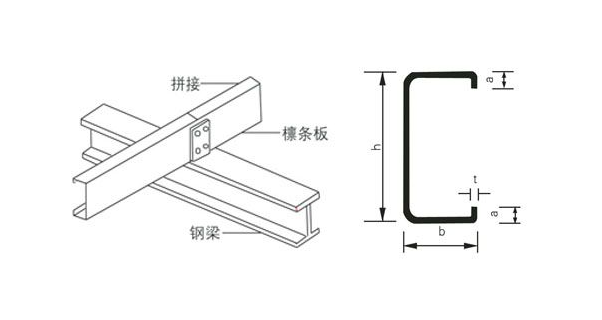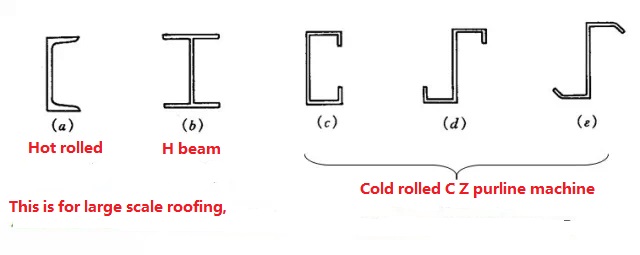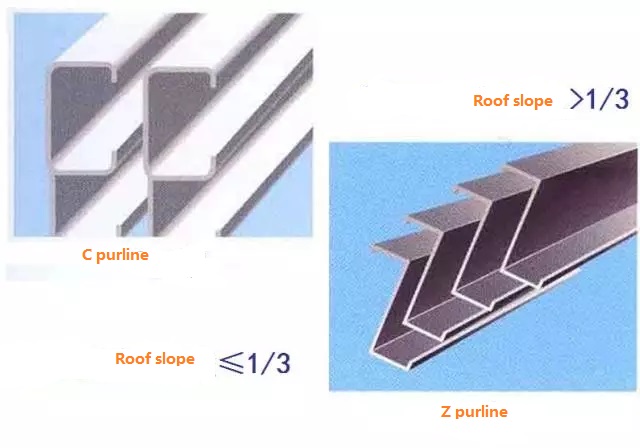How to count how many C purline or Z purline you need when building the house?
In the market, for the purline there are following types for your reference. As when and why, how to choose, here are some tips for your reference:
1.Solid-web cold-formed thin-walled steel sections are widely used in engineering. Among them, hemming channel steel (also known as C-shaped steel) purlins are suitable for roof slope i≤1/3.
- Straight edge and oblique curled edge z-shaped purlins are suitable for roof slope i>1/3. The oblique crimped Z-shaped steel can be stacked in layers when stored, and it occupies a small area. When making continuous beam purlins, the structure is also very simple.
★ Load and load combination of purlin
- 1.2×permanent load+1.4×max{even live load on roof, snow load};
- 1.2×permanent load+1.4×conversion value of concentrated load for construction and maintenance.
When it is necessary to consider the influence of wind suction on the force of the roof profiled steel plate, the following load combination should also be carried out:
- 1.0×permanent load+1.4×wind suction load.
★ Internal force analysis of purlin
- Under the action of uniform load perpendicular to the ground, the purlin set on the inclined beam of the rigid frame has a bending moment along the two centroid main axes of the section, which is a bidirectional bending member (different from the general bending member).
- In the internal force analysis, the uniform load must first be decomposed into the load components qx and qy along the main axis of the section centroid.
- The calculation diagram of C-shaped purlin under load is as follows:
The calculation diagram of Z-type purlin under load is as follows:
★ Cross-section check calculation of purlin—strength, overall stability, deformation
Strength calculation—calculated based on bidirectional bending member
When the roof can prevent the instability and torsion of the purlin, the section can be checked according to the following strength formula:
★ Arrangement of braces and struts
- When the wind suction exceeds the permanent roof load, the direction of the lateral force is opposite. At this time, the diagonal strips of the Z-shaped steel sandalwood strips need to be installed at the ridge, while the crimped channel steel purlins need to be installed at the eaves.
- Therefore, in order to take into account the two situations, install diagonal braces in areas with high wind load or at the eaves and ridges, or make both horizontal braces and diagonal braces rigid that can bear both tension and pressure. Rod.
- The brace is usually made of round steel, and the diameter of the round steel should not be less than 10mm. The round steel brace can be set within 1/3 of the height of the web from the upper flange of the purlin.
- When the lower flange of the purlin is compressed under the action of wind suction, the roof should be directly connected to the purlin with self-tapping screws, and the brace should be set near the lower flange.
- In order to take into account both windless and windy conditions, it can be arranged alternately near the upper and lower flanges.
The connection of the brace, the brace and the purlin is shown in the figure. The diagonal brace can be bent or not. The former method requires that the length of the bent straight line does not exceed 15mm, and the latter method needs to be connected to the purlin through an inclined plate or angle steel.
The solid web type purlin can be connected to the rigid frame inclined beam through the purlin. The purlin can be made of angle steel and steel plate. The connecting bolts of the purlin and the purlin shall not be less than two, and they shall be arranged along the height direction of the purlin, as shown in the figure below. The purpose of setting the purlin is to prevent the torsion of the cross section of the end of the purlin to enhance its overall stability.
★ Calculation of the strip:
The formula for calculating the cross-sectional area required by the brace:
★ Purlin design-summary
- According to the characteristics of the force, the purlin should be subjected to internal force calculation and section design according to the bidirectional bending member.
- During internal force analysis of purlins, the calculation of internal force is related to the arrangement of braces. When one or two braces are arranged, the calculation is based on two-span or three-span continuous beams under the action of horizontal load qx.
- The arrangement of the brace should consider the influence of wind load, calculate the cross section of brace according to the actual force, and meet the structural requirements.












